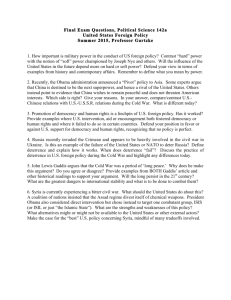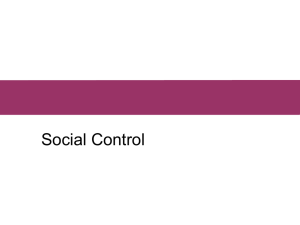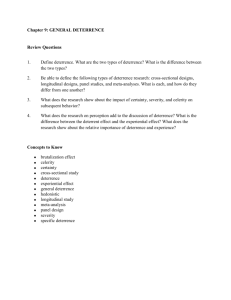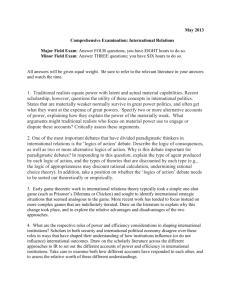6 The RAND Corporation is a nonprofit from
advertisement
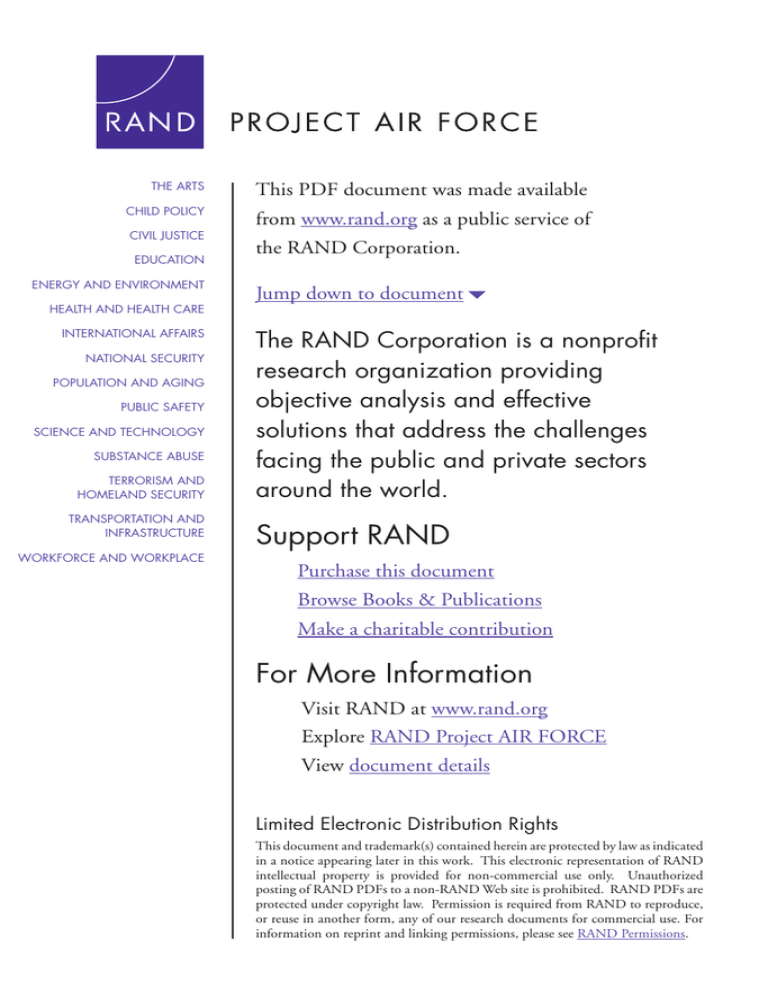
THE ARTS This PDF document was made available CHILD POLICY from www.rand.org as a public service of CIVIL JUSTICE EDUCATION ENERGY AND ENVIRONMENT HEALTH AND HEALTH CARE INTERNATIONAL AFFAIRS NATIONAL SECURITY POPULATION AND AGING PUBLIC SAFETY SCIENCE AND TECHNOLOGY SUBSTANCE ABUSE TERRORISM AND HOMELAND SECURITY TRANSPORTATION AND INFRASTRUCTURE WORKFORCE AND WORKPLACE the RAND Corporation. Jump down to document6 The RAND Corporation is a nonprofit research organization providing objective analysis and effective solutions that address the challenges facing the public and private sectors around the world. Support RAND Purchase this document Browse Books & Publications Make a charitable contribution For More Information Visit RAND at www.rand.org Explore RAND Project AIR FORCE View document details Limited Electronic Distribution Rights This document and trademark(s) contained herein are protected by law as indicated in a notice appearing later in this work. This electronic representation of RAND intellectual property is provided for non-commercial use only. Unauthorized posting of RAND PDFs to a non-RAND Web site is prohibited. RAND PDFs are protected under copyright law. Permission is required from RAND to reproduce, or reuse in another form, any of our research documents for commercial use. For information on reprint and linking permissions, please see RAND Permissions. This product is part of the RAND Corporation monograph series. RAND monographs present major research findings that address the challenges facing the public and private sectors. All RAND monographs undergo rigorous peer review to ensure high standards for research quality and objectivity. Deterrence and First-Strike Stability in Space A Preliminary Assessment Forrest E. Morgan Prepared for the United States Air Force Approved for public release; distribution unlimited PR OJ ECT AIR FORC E The research described in this report was sponsored by the United States Air Force under Contract FA7014-06-C-0001. Further information may be obtained from the Strategic Planning Division, Directorate of Plans, Hq USAF. Library of Congress Cataloging-in-Publication Data Morgan, Forrest E. Deterrence and first-strike stability in space : a preliminary assessment / Forrest E. Morgan p. cm. Includes bibliographical references. ISBN 978-0-8330-4913-1 (pbk. : alk. paper) 1. Space warfare--Government policy--United States. 2. Space weapons--United States. 3. Deterrence (Strategy). I. Title. UG1523.M587 2010 358'.8--dc22 2010008354 The RAND Corporation is a nonprofit research organization providing objective analysis and effective solutions that address the challenges facing the public and private sectors around the world. RAND’s publications do not necessarily reflect the opinions of its research clients and sponsors. R® is a registered trademark. © Copyright 2010 RAND Corporation Permission is given to duplicate this document for personal use only, as long as it is unaltered and complete. Copies may not be duplicated for commercial purposes. Unauthorized posting of RAND documents to a non-RAND Web site is prohibited. RAND documents are protected under copyright law. For information on reprint and linking permissions, please visit the RAND permissions page (http://www.rand.org/publications/permissions.html). Published 2010 by the RAND Corporation 1776 Main Street, P.O. Box 2138, Santa Monica, CA 90407-2138 1200 South Hayes Street, Arlington, VA 22202-5050 4570 Fifth Avenue, Suite 600, Pittsburgh, PA 15213-2665 RAND URL: http://www.rand.org To order RAND documents or to obtain additional information, contact Distribution Services: Telephone: (310) 451-7002; Fax: (310) 451-6915; Email: order@rand.org Summary Space stability is a fundamental U.S. national security interest. Unfortunately, that stability may be eroding. Since the end of the Cold War, U.S. military forces have repeatedly demonstrated their dominance in conventional warfare, and future enemies will be well aware that the dramatic warfighting advantage that U.S. forces possess is largely the result of support from space. With a growing number of states acquiring the ability to degrade or destroy U.S. space capabilities, the probability that space systems will come under attack in a future crisis or conflict is ever increasing. Deterring adversaries from attacking some U.S. space systems may be difficult due to these systems’ inherent vulnerability and the disproportionate degree to which the United States depends on the services they provide. Nevertheless, the United States can fashion a regime to raise the thresholds of deterrence failure in terms of destructive attacks on its space systems and thus achieve a measure of first-strike stability in space during crises and at some levels of limited war. (See pp. 7–16.) Estimated Thresholds of Space Deterrence Failure While the factors above suggest that stability in space is eroding, it would be overly simplistic to assume that the thresholds of deterrence failure are the same for all space systems or at all levels of confrontation. In any given crisis or conflict, an adversary would have to weigh a range of factors in contemplating attacks on U.S. space capabilities. The risks incurred or benefits expected in a space attack would vary greatly ix x Deterrence and First-Strike Stability in Space: A Preliminary Assessment in the context of any specific scenario. Consequently, it is less a question of whether would-be aggressors can be deterred from attacking U.S. space systems than of what kinds of attacks against which capabilities could be deterred under what circumstances. (See pp. 16–21.) As Figure S.1 illustrates, an adversary’s assessment of the costs and benefits of attacking a U.S. space system would likely vary from one prospective target set to another at each level of conflict, and the threshold of deterrence failure would be different for nondestructive attacks (i.e., “reversible-effects” attacks) than for destructive attacks (those that cause damage). (See pp. 16–21.) Some of these thresholds are quite low today. An opponent in a confrontation with the United States that has not yet engaged in conventional terrestrial hostilities might consider reversible-effects attacks on U.S. space-based intelligence, surveillance, and reconnaissance (ISR) and communication assets to be a promising means of degrading the United States’ ability to respond to the crisis, with relatively low risk of serious retribution compared to that of a destructive attack on one or more U.S. satellites. Fearing the onset of U.S. air strikes, the adversary might also begin jamming Global Positioning System (GPS) signals in areas around command-and-control nodes and other important facilities to degrade the accuracy of U.S. precision-guided weapons. Even after fighting has begun, a savvy adversary might continue to abstain from destroying U.S. satellites in a limited war for fear of escalating the conflict, particularly if the reversible-effects attacks continued to yield comparable levels of benefit. However, should the terrestrial conflict escalate, it would become increasingly difficult to deter an enemy with the appropriate capabilities from carrying out destructive attacks in space. At some point, the conflict would likely reach a threshold at which the growing benefits of transitioning to destructive attacks on certain space systems would overtake the dwindling costs of doing so. In fact, satellites used for reconnaissance and ocean surveillance—being high-value, low-density assets—might become targets even at relatively low levels of conflict, and the adversary might attempt to damage dedicated U.S. military satellite communication (MILSATCOM) assets as well. (See pp. 16–21.) Summary xi Conversely, since commercial satellite communication (SATCOM) platforms typically support a host of international users as well as U.S. forces, the political costs and escalatory risks of carrying out destructive attacks on those assets might deter the opponent from attempting to do so until the conflict escalated to a higher level. Satellites supplying positioning, navigation, and timing (PNT) data—i.e., GPS— would probably be relatively safe from destructive attack until very high levels of conflict, because the distributed nature of that system would make it difficult for an opponent to realize much benefit from individual attacks. The adversary would also likely be deterred from damaging U.S. satellite early-warning system (SEWS) assets to avoid risking inadvertent escalation to the nuclear threshold, but that firebreak would almost certainly collapse with the conclusion that such escalation is inevitable and that it is in the adversary’s interest to launch a preemptive nuclear strike. Alternatively, because the strategic surveillance and warning system also supports efforts to locate and destroy mobile Figure S.1 Notional Space Deterrence Capabilities, by System Type at Various Levels of Conflict General nuclear war Ability to deter nondestructive attack Ability to deter destructive attack Nuclear threshold Conventional threshold Crisis Tension SEWS ISR Weather PNT MILSATCOM SATCOM NOTE: The information shown in this figure is provided for illlustrative purposes only and is not based on an analysis of empirical data. RAND MG916-S.1 xii Deterrence and First-Strike Stability in Space: A Preliminary Assessment conventional missile launchers, the adversary might risk dazzling SEWS satellites at lower levels of conflict to impede U.S. efforts to locate and destroy those launchers. (See pp. 16–21.) Weather satellites, surprisingly, might be the space assets that are safest from attack. Attacking assets supporting the highly globalized international meteorological system would result in considerable political costs, and the robust infrastructure supporting that system would limit the benefits of individual attacks against it. (See pp. 16–21.) Space Deterrence and General Deterrence Although this assessment focuses specifically on space deterrence and first-strike stability in space, it is important to appreciate the interdependencies between these factors and general deterrence and stability writ large. Given the extent to which space support enhances U.S. conventional military capabilities, an adversary weighing the risks and potential benefits of war with the United States might be encouraged toward greater aggression by the belief that attacking space systems would degrade U.S. warfighting capabilities enough to enable the attainment of objectives at acceptable costs. As a result, weaknesses in space deterrence can undermine general deterrence. Conversely, if a prospective adversary concludes that the probable cost-benefit outcome of attacking U.S. space systems is unacceptable, it is forced to weigh the risks and benefits of aggressive designs in the terrestrial domain against the prospect of facing fully capable, space-enhanced U.S. military forces. In sum, effective space deterrence fortifies general deterrence and stability. (See p. 21.) Deterrence in the Space Environment Deterrence entails discouraging an opponent from committing an act of aggression by manipulating the expectation of resultant costs and benefits. Deterring attacks on U.S. space systems will require the United States to fashion credible threats of punishment against potential opponents, persuade adversaries that they can be denied the bene- Summary xiii fits of their aggression, or some combination of both approaches. However, fashioning a space deterrence regime that is sufficiently potent and credible will be difficult given that U.S. warfighting capabilities, much more so than those of any potential adversary, depend on space support. Threatening to punish aggressors by destroying their satellites might not deter them from attacking U.S. assets—a game of satellite tit-for-tat would likely work to the adversary’s advantage. Conversely, threats of punishment in the terrestrial domain may lack credibility in crises and at lower levels of limited war and would likely be irrelevant at higher levels of war, when heavy terrestrial attacks are already under way. Denial strategies face other hurdles. Efforts to deny adversaries the benefits of space aggression are hindered by the inherent vulnerability of some important U.S. space systems and the high degree of U.S. dependence on those assets. As long as those systems are vulnerable, the enemy’s benefit in attacking space assets is proportionate to the United States’ dependence on the capabilities they provide. (See pp. 24–33.) The Task Is Not Impossible While these factors suggest that it may be difficult to deter potential enemies from attacking certain U.S. space systems in some circumstances, the task of strengthening first-strike stability in space is by no means impossible. As illustrated earlier, the orbital infrastructures of some U.S. systems are already sufficiently robust that they present poor targets for prospective attackers. The challenge will be to find ways to raise the thresholds of deterrence failure for those systems that are both vulnerable and important for force enhancement. Meeting this challenge will require the United States to develop and employ a coherent national space deterrence strategy. (See p. 35.) The Need for a National Space Deterrence Strategy The United States can raise the thresholds of deterrence failure in crises and at some levels of limited war by implementing a coordi- xiv Deterrence and First-Strike Stability in Space: A Preliminary Assessment nated national space deterrence strategy designed to operate on both sides of a potential adversary’s cost-benefit decision calculus simultaneously. The foundation and central pillar of such a strategy would be a national space policy that explicitly condemns the use of force in space and declares that the United States will severely punish any attacks on its space systems and those of friendly states in ways, times, and places of its choosing. Cognizant of the fundamental U.S. interest in space stability, such a policy would embrace diplomatic engagement, treaty negotiations, and other confidence-building measures, both for whatever stabilizing effects can be attained from such activities and because demonstrating leadership in these venues helps to characterize the United States as a responsible world actor with the moral authority to use its power to protect the interests of all spacefaring nations. In these settings and others, all U.S. policies, statements, and actions should be carefully orchestrated to bolster already emerging international taboos on space warfare and enhance the credibility of U.S. threats to punish space aggressors in multiple dimensions—in the terrestrial and informational domains as well as in space, through diplomatic and economic means, in addition to the use of force. Such an approach would raise the potential costs in ways that future opponents would have to factor into their decision calculations in any crisis in which they are tempted to attack orbital assets. (See pp. 37–44.) At the same time, the United States should engage in a comprehensive and coordinated effort to persuade potential adversaries that the probability of obtaining sufficient benefit from attacking space assets would not be high enough to make it worth suffering the inevitable costs of U.S. retribution. Part of such a strategy would entail perception management: The United States should, to the greatest extent possible, conceal vulnerabilities of its space systems and demonstrate the ability to operate effectively without space support. However, perception management can only go so far in the face of observable weaknesses. Therefore, the strategy should also pursue multiple avenues to make vulnerable U.S. space systems more resilient and defendable, thereby demonstrating tangible capabilities to deny potential adversaries the benefits of attacking in space. (See pp. 44–45.) Summary xv Although satellites are inherently difficult to defend, there are a variety of options that the United States should explore for reducing the vulnerabilities of its space systems. Possibilities include making greater investments in passive defenses, exploring approaches to active defenses, dispersing capabilities across a larger number of orbital platforms, and developing terrestrial backups to space support. It may also be beneficial to disperse some U.S. national security payloads onto satellites owned by a range of other nations and business consortia friendly to the United States and also to engage in data-sharing arrangements with them. Such approaches would create an international security space infrastructure that is more robust than the sum of its individual systems, raise escalation risks for anyone contemplating attacks on that infrastructure, and strengthen international support for U.S. threats of punishment in response to attacks. (See pp. 45–48.) Current deficiencies in space situational awareness (SSA) are sources of particular concern. While many options exist for punishing space aggressors and reducing the benefits of their attacks, nearly all of them depend to some degree on improvements in SSA. Poor SSA undermines the credibility of threats of punishment in some scenarios, as the attacker may expect to have a reasonable chance of striking anonymously. All active defenses require better SSA than what current capabilities provide, and many passive defenses could also be improved with better SSA. Improving SSA should be one of the United States’ top priorities in its efforts to develop the capabilities needed for an effective space deterrence regime. (See p. 48.) A Way Forward Although this monograph proposes the broad outlines of a comprehensive space deterrence regime, more work is needed to evaluate which of the various options discussed here are viable and what combination would best support a reliable strategy. Such work would consist of an integrated analysis of the space deterrence problem as a complex system and an examination of the consequences of alternative courses of action, both by the United States and by its most likely potential xvi Deterrence and First-Strike Stability in Space: A Preliminary Assessment adversaries, across a range of scenarios. Insights gained from such an examination would inform further analyses to determine near- and farterm approaches for achieving the optimal mix of policies, strategies, and systems for establishing the most effective and affordable deterrence regime. (See pp. 51–53.) This effort would entail a broad investigation, bringing a wide range of analytical methods to bear and ultimately integrating technical assessments with expert judgment. Planners would need to gather a good deal of information, but much of it is available from intelligence sources or has already been developed in previous studies. The investigation would begin with surveys of that work. Risk analyses and engineering assessments would play important roles in determining degrees of vulnerability and the most promising approaches for mitigating them. Crisis-gaming and war-gaming would be essential tools for exploring the dynamics of deterrence and stability across a range of scenarios and levels of conflict. Other aspects of the investigation would include an examination of space law and consultation with space experts in the U.S. analytical community and elsewhere. Ultimately, having gathered the findings of the surveys, assessments, and analyses, planners would be able to refine and further develop the comprehensive space deterrence strategy outlined in this monograph and offer recommendations for its implementation. (See pp. 51–53.)

